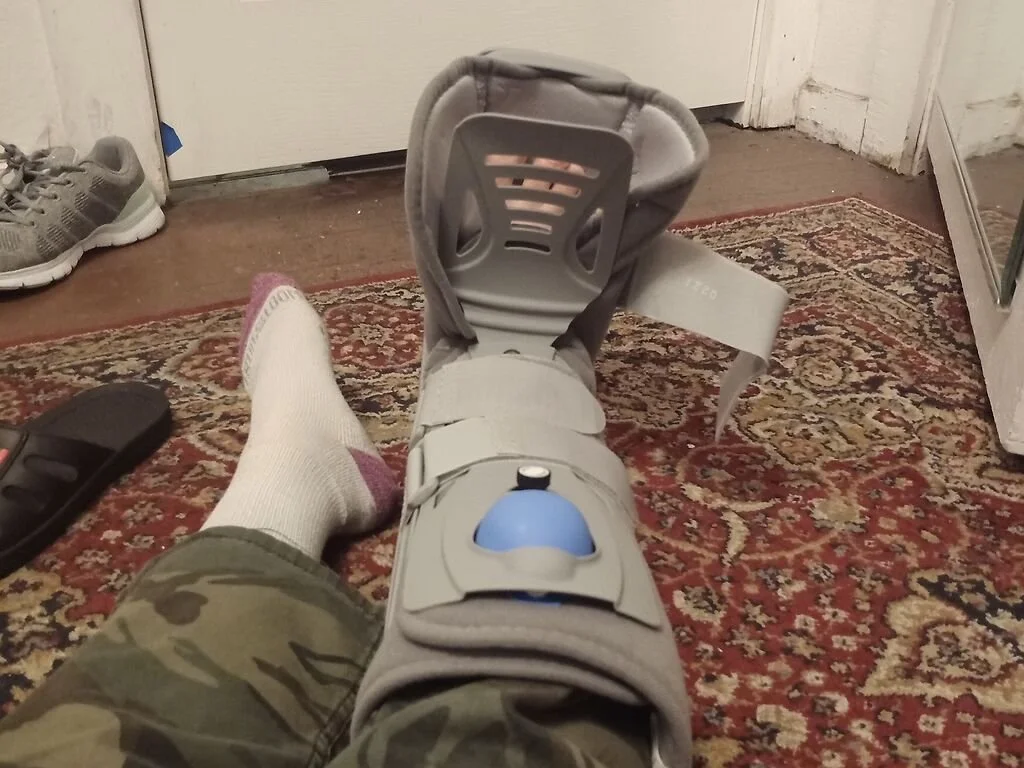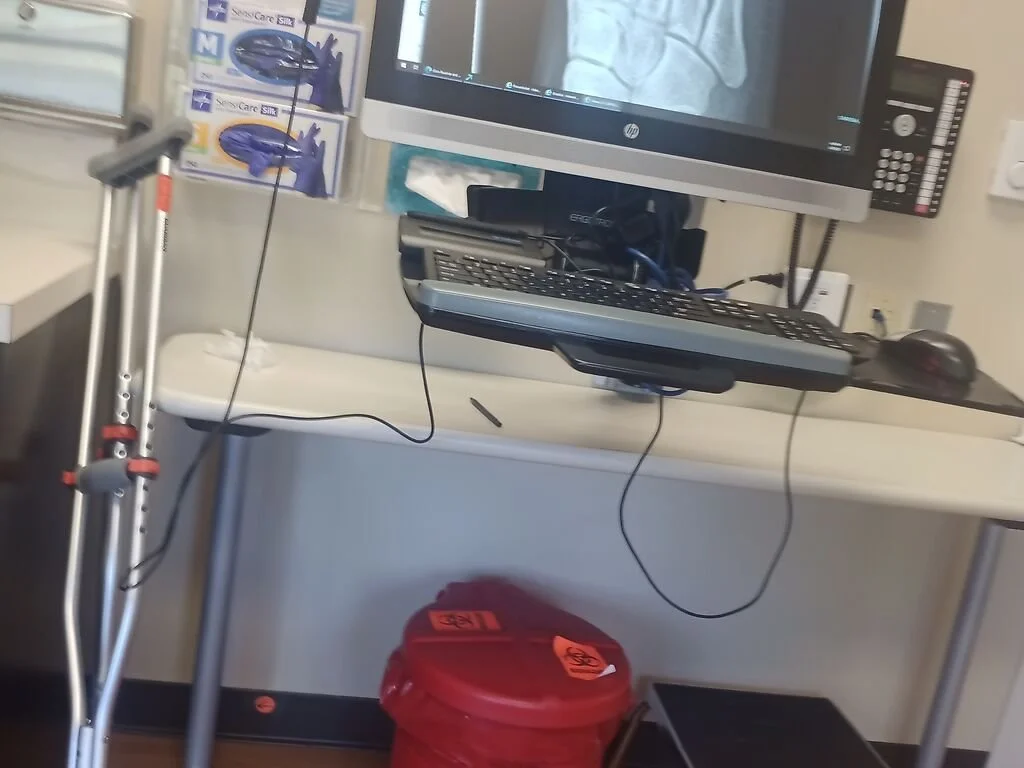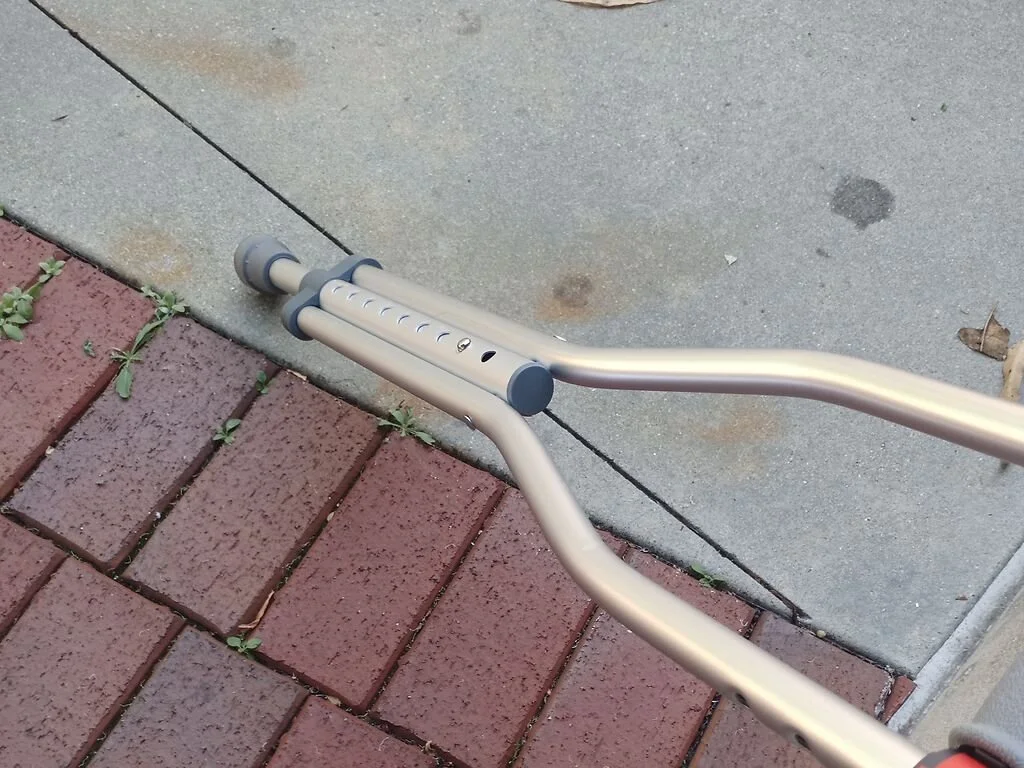Student Life With a Broken Foot
By: Catherine Chen ‘24
Ever since I injured my right foot last month in a sports-related accident, life has become a series of unique challenges and experiences. I’ve gradually learned how to live and survive life with no use of my right leg. Below are some of the things I learned, resources I used, and other things to expect should you ever (but hopefully never!) happen to fracture a bone while at USC.
1) Fracturing a bone doesn’t necessarily mean you’ll be in unbearable pain.
It depends on where and how severe the injury is, but the pain of a fracture could be less than you expect. Personally, when it happened to me, I felt a sort of “pop” in my foot and heard a matching noise. Pain immediately registered in my brain. It was intense, but not so bad that I thought I’d broken or fractured a bone. It wasn’t until the pain woke me up crying in the middle of the night that I realized the injury might be more serious than I originally thought.
X-rays taken later that day showed that I’d fractured two metatarsal bones in my right foot. The general physician gave me a boot cast, called an air walker, along with crutches, then booked me for an appointment with an orthopedic specialist the next week. Since my fractures were comminuted (broken in more than one place) and mildly displaced, the physician was worried that I would possibly need surgery, although thankfully I didn’t.
My foot in a boot cast.
2) Take care of yourself and your mental health.
I wish I’d known sooner, but I didn’t expect the mental and emotional strain my fractured foot would put on me. With any kind of injury, you often find yourself thrown into a place where you aren’t able to do many of the things you used to before. Definitely be kind to yourself! Giving your mind and body the time it needs to adjust to your new situation will go a long way. (Check out the other great Trojans360 articles on self care tips too!)
3) Utilize ALL the campus resources you can.
Don’t be afraid to ask around if you need anything! I actually learned about USC DART (see below) by posting a question on Reddit. Since then, I’ve discovered that USC has quite a few services that make the experience of being a student with an injury much easier.
Engemann Student Health Center:
Trying to sign up for an in-person same-day appointment is nearly impossible, but telemedicine appointments tend to be easy to book. Walk-ins are also sometimes possible. I was lucky to be able to book an online appointment the day after my foot was injured, and the physician who saw me gave me an in-person appointment at the Student Health Center that same afternoon. The Health Center has four floors and a variety of services, from immunizations, to radiology, to lab testing (such as for COVID-19 or sexually transmitted diseases). I visited the general physician, got x-rays taken, and saw an orthopedic specialist there – the whole package, without ever having to set foot off campus.
One of the rooms in the Engemann Student Health Center.
USC DART:
DART stands for “Disabled Access to Road Transportation” and is a service designed for USC students, faculty, and staff who may have challenges getting around campus, whether that be permanent or temporary. To get started with DART, you’ll need to fill out an online form that asks about your condition, how long you estimate the services need to last, and what assistance (crutches, knee scooter, wheelchair, etc.) you are using.
Once you fill out the form, you can start utilizing DART services right away! The staff and student workers at DART are quick at responding, especially with calls and texts. They were able to get me a ride to one of my classes the very next day, and have been super accommodating, especially with my crazy schedule and frequent pickup changes. I’ve loved my experience with DART so much. The golf cart drivers are mostly student workers, and I was pleasantly surprised to find some of my friends picking me up, in addition to making new friends with other drivers. Also, you don’t need to be registered with USC OSAS (see next section) to take advantage of DART! Just keep in mind that DART carts can’t go off campus onto the main roads, so if you live off campus, you’ll still need to get onto campus by yourself.
USC OSAS:
I personally didn’t sign up with USC’s Office of Student Accessibility Services, but if you need academic accommodations beyond transportation, OSAS is the way to go. For example, extra time on exams is sometimes given to students with injuries to account for the fact that pain distracts them from being able to focus completely. You can register with OSAS here or visit the website at USC Office of Student Accessibility Services.
4) Getting around is difficult, but not impossible.
Aside from USC DART services, crutches were my primary form of transportation. I did debate over whether or not to get a knee scooter, though. Knee scooters are much, much faster to travel around on than crutches, but also cost more (usually $110-200). In addition, I didn’t want to give up the chance to be able to grow some amazing biceps. :)
The three factors that made getting around difficult (whether with crutches or a knee scooter) were doors, stairs, and trying to carry things.
Doors:
I’m still having an internal debate with myself over whether heavy or light doors are harder to deal with. Light doors are easier to push but tend to shut faster than heavy doors, especially if you accidentally push too hard. But because they’re easier to push, light doors tend to give you more space to maneuver through.
Opening a door by myself was possible after a bit of practice. I would push the door open and stabilize it with one hand (you can only use one hand at a time), move my crutches/foot forward a bit, then repeat the process. Then when I felt the timing was right, I would give the door one last, big shove and move out of the way as quickly as possible.
The easiest way to open a door, however, is to ask someone. Sometimes I didn’t even need to ask – most strangers who watched me struggle to open a door were very kind and would run over to give me a hand.
Stairs:
Stairs are awful, period. I still sometimes forget whether my foot or crutches go first (crutches first when going down, foot first when going up), and that never ends well. In addition, balancing is a constant challenge. Going up is easier for me, and I will use side railings whenever I need to when going down. It’s a process of moving my crutches down to the next step, grabbing the railing with one hand (squeezing the space under my arm to keep the crutch in place), moving my foot down, and repeating the sequence. Luckily, the majority of buildings at USC have elevators – but if you have a class on the second floor of PED like I did, well, good luck. I have heard there is a “secret” elevator in the building, but that it only goes down to the basement, not up.
Carrying Stuff:
It’s not really possible. The best way I’ve found is to use a backpack; the crutch pad will feel a bit weird under your armpits, but you grow used to it. Just beware – a heavy backpack will throw you off balance whenever you’re trying to (1) put it on or (2) go up and down stairs!
Using a backpack isn’t always practical or probable, however. Below are three methods I’ve used to move things around my room and house:
Using crutches to push objects, while still trying not to throw myself off balance.
Using my mouth for very light, thin objects such as ice cream bar sticks, pens/pencils, pieces of paper, and so forth.
Carrying light objects in bags by holding the bag and the crutch handgrip at the same time.
Carrying certain shaped objects (such as books) by tucking them between my forearm and the crutch.
Using only one crutch, holding what I need to hold using my other hand, and limping/hopping to my final destination (it only works for extremely short distances).
Other than those above challenges, getting around basically just took a lot of patience, time, and energy. I remember the first few times I made the 500-foot trek between my place and the closest building on campus, each ended with me nearly in tears from the exhaustion and length of time it took me to finish the journey. But things definitely got easier over time!
Other miscellaneous points of interest:
Food options: I live off campus, so grocery delivery services like Amazon Fresh and Instacart really helped to keep me sustained. I’m not sure about Instacart, but certain Amazon Fresh items do take EBT cards!
Dealing With Pain: The doctor will generally tell you to take Advil or Ibuprofen. Besides medications, I’ve found cold sticky pads to be super helpful when dealing with pain. I apply them every day to the injured portion of my foot.
The medicated patches I use for my foot.
Chemistry & Biology Labs: If you are taking any lab classes, make sure to tell your professors and lab instructors about your situation. In chem and bio labs, I generally slide my crutches under the table and do on-bench parts of the experiment while my labmates walk around to get materials, wash equipment, etc. For chemistry, you’ll probably be recommended to wear a boot over your cast, which you can get from the chemistry stockroom.
5) Support your friends who have injuries.
If you have a friend who got injured, there are definitely things you can do to help them! Check in on them – they could be feeling lonely, frustrated, or just need someone to talk to. Ask if there is anything you can do to help – whether picking up food or items at Target, carrying things around, or anything else. Other than that, just be the awesome and supportive friend you’ve always been!
Good Luck!
I hope this post’s been helpful to you, whether you’re curious about what life with a fractured foot is like, or are looking for tips on how to navigate the practical parts of life on crutches. If you ever have any questions or need someone to talk to after an injury, definitely feel free to reach out to me!
Want more from Trojans 360?
Visit Trojans 360 on Facebook & Twitter to stay up to date with more student content! You can also Ask A Trojan an anonymous question, and we’ll try to answer it in a future post. And don’t forget to follow us on Instagram!
Trojans 360 is USC’s official student-run blog. Content created by students, for students.





